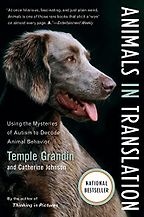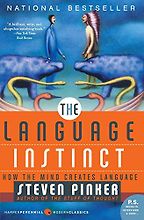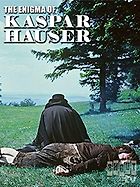Could you give us a brief introduction to your work?
I’m the director of the Autism Research Centre. We look at people on the autistic spectrum and we try to understand those people at multiple levels, from psychology – how their mind works – through to the neural level – how their brain works – right through to the biochemical and ultimately the genetic level. So, it’s multidisciplinary. And we also evaluate interventions that might be helpful forms of support. There are scientists working here with very varied backgrounds, working collaboratively.
Your first choice, The Curious Incident of the Dog in the Night-Time by Mark Haddon, is a fictional portrayal of autism.
The main character is a young boy who is completely confused by the social interactions of people in his community and in his family, but he’s also very precocious in mathematics. The book describes, albeit fictionally, the disconnect between his understanding of systems – in this case mathematical, numerical systems – and his major difficulties in understanding people.
How accurate is the portrayal?
I think in fiction the writer has some licence to deviate from what is real – it’s a work of art, ultimately, for people’s interest and enjoyment, but I think that the character is very recognisable of many people on the autistic spectrum. I think the author has done a very good job.
There’s also an extra element in that this boy is a victim of domestic violence, and that’s certainly not seen in most autistic children, so if the reader is trying to figure out what’s causing what, it’s quite difficult to disentangle. Are his difficulties just the result of his autistic spectrum condition, or the result of early neglect and abuse?
The other appeal of this book is that the main character walks around his village looking at clues, to make sense of what has happened. In this sense, the autistic child is thinking like a detective, to get at the truth, and this speaks to autistic children’s strong interest in ‘systemizing’ or looking for patterns in the world that can be confirmed through evidence.
It’s a book that I would recommend, because I think it has a very original style – it’s very engaging. The risk that this book carries is that people who read it might think that all children on the autism spectrum have strong mathematical talents, which is not the case – there’s a slight risk of misrepresentation. But as a work of fiction, it does a good job of engaging the reader through a character who is clearly different.
In popular fiction, autistic characters are commonly portrayed as savants – someone who has an island of expertise, despite developmental difficulties. But actually this is quite rare, isn’t it?
Well, it is unclear what proportion of autistic people are savants. Savant syndrome certainly seems to be more common in people on the autistic spectrum, compared to any other group of people with a clinical diagnosis, so there’s definitely a link, but we need more research into the reason for this link and its prevalence.
Let’s move on to your second recommendation—which is actually a film: The Enigma of Kaspar Hauser (1974), by Werner Herzog. Could you tell me why you recommend it?
I saw this film more than 30 years ago. It describes an enigmatic real-life character who turned up in a village in Nuremberg in 1828. He has no language and seems completely outside of human culture, and is taken in by a local doctor who tries to socialise him.
Part of the enigma about Kaspar Hauser was his origins: Was he abandoned? Did he have an important family history? But the big question the film raises is how could somebody end up outside of human society, and find it so hard to develop language and to make sense of people?
Kaspar Hauser might be the first well-documented case of autism in literature, even in history. If some people wonder whether autism is just a modern phenomenon, here we have a very early account. The film (and the original book) raises very similar issues to those raised in The Curious Incident of the Dog in the Night-Time, and shares a main character who is somehow detached from humanity. Like The Curious Incident, Kaspar Hauser also suffered neglect and abuse (of a different kind – he was reportedly chained up and isolated for the first 17 years of his life), and again this is not common among autistic people. Indeed, it could be more similar to the case of Genie, a so-called feral child who was also reared in isolation and never properly developed language or social skills.
It’s interesting that both Haddon and Herzog have managed to create such compelling narratives when the central characters are so difficult to relate to. It’s the opposite approach to the advice of many creative writing instructors.
I think readers have a fascination with a character who is outside of mainstream culture. Some autistic people describe themselves as feeling as though they came from another planet: they watch human interaction and they don’t quite understand it. There’s even a website created by autistic people: wrongplanet.net. It creates an outsider’s point of view, which I think works very well in literature and film.
Your next book sounds is intriguing. Tell us about Animals in Translation, by Temple Grandin—a woman who has studied animal behaviour through the prism of her own autism.
This book is unusual for lots of reasons. I found it really gripping. For me, as a scientist who has been looking at autism from the outside, I felt there is so much we can learn from her because she is autistic herself, and is able to tell us what the world looks like from her point of view.
She is a professor in the US who received her diagnosis of autism in childhood. Her previous book mphasised the visual aspect of her experience. She called it ‘thinking in pictures.’ The idea is that whereas most of us think in words, many autistic people think in images – as if they have a series of photographs in their minds. In the book that I have picked, Animals in Translation, she has also highlighted the way that autistic people are hypersensitive to the sensory world. They may notice things that other people miss and they may react to sensory stimuli in much more extreme ways. It could be sounds, it could be visual.
Certain kinds of touch are really difficult for autistic people, such as human touch, perhaps because it is unpredictable, and autistic people prefer predictability. But Temple Grandin designed a machine that she calls the squeeze machine, which you can climb into and it presses you, and you can adjust how much pressure you have from it, which she finds very soothing. When the touch and pressure is under the autistic person’s control, she reports that for her it is as nice as a hug.
Does this book helps us empathise with people like Grandin because it leads to a greater understanding of their world?
Yes, and the other dimension to this book is that as an autistic person she is a very acute observer. She uses that skill to observe other animals and draws the comparison between how autistic people react to different sensations and how animals do as well. She has used that very productively in her own career. She designs equipment for the agriculture industry, for example. In this sense, she has ‘systemized’ animal behaviour, being able to predict what will cause them anxiety and what will calm them, and perhaps she has excelled in this because non-human animal behaviour is a bit simpler than human interaction, particularly verbal communication, which cannot easily be systemized.
Your fourth book recommendation is The Language Instinct by Stephen Pinker. This is a set text on many psychology undergraduate courses.
This is a popular science book from a highly respected cognitive scientist. He took one part of the mind, language, and looked at it from every angle. It’s a really wonderful example of what you can do: take research into something as fundamental to human nature as language and make it accessible to a wide audience.
He looks at how infants develop language, whether other animals are capable of understanding language, how the brain produces and processes language, how language evolved, the role of experience versus genetic factors in language, how we use language in the media… He looks at it from every angle. It was, deservedly, a very popular and successful book. Language is at the core of many of the humanities, yet here was a writer addressing it as a scientist. His book is of interest both to those in the arts and the sciences, given the centrality of language to being human.
Your final book is John Bowlby’s Attachment. Why?
Bowlby’s Theory of Attachment, first published in the 1950s, was a very simple but powerful idea. In essence he told us something that we all knew, which was that the emotional bond between a parent and a child is really important. But he didn’t just say this anecdotally, he said it on the basis of his clinical experience. He was working at the Tavistock Clinic in London, where he worked with children who hadn’t had the luxury of strong relationships with their parents. Many had been brought up in a children’s home, and many had developed delinquency or other problems by their teens. And just as Steve Pinker looked at language from the perspective of great apes or dolphins, Bowlby looked at attachment behaviour from the perspective of many different species. He unified the study of parent-offspring relations across the animal kingdom.
The reason I’ve selected it here is that it’s a very nice example of an environmental influence that affects all of our outcomes in adulthood. Whereas Pinker talks about genetic or innate factors that predispose humans to produce and understand language, Bowlby reminds us that our early experience and our social environment is equally important. What Bowlby’s studies have shown, now confirmed by scientists who came after him, is that the quality of your attachment to your parents can predict not just short-term outcomes, like how well you do at school and your social popularity, but also long-term outcomes like your risk of divorce and your risk of developing personality disorders in adulthood.
How does the attachment relationship change in the case of autistic children?
Sometimes people imagine that children with autism don’t form any relationships at all, but that’s a myth. They do show selective relationships just like other children, showing a preference for their caregiver, whether that’s a biological parent or a foster parent. They are capable of showing strong emotional attachment. But you’re right in that attachment is likely to be different for an autistic child. A typically developing child who is securely attached would be expected to be very confident and able to go out and explore the world. In the case of an autistic child, clearly there are many other factors that could mediate whether that person will end up socially withdrawn or very confident.
This interview was first published in 2010 and updated in 2024.
Interview by Cal Flyn, Deputy Editor
September 16, 2024. Updated: September 18, 2024
Five Books aims to keep its book recommendations and interviews up to date. If you are the interviewee and would like to update your choice of books (or even just what you say about them) please email us at [email protected]
Five Books interviews are expensive to produce. If you've enjoyed this interview, please support us by donating a small amount.












